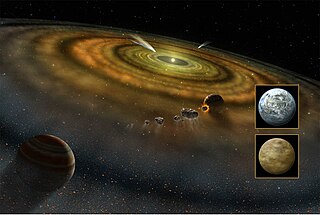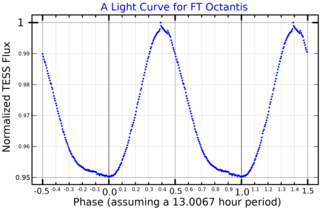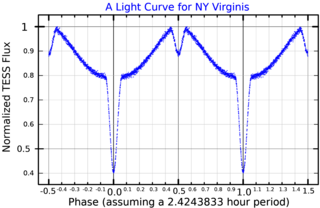ADS 16402 is a binary star system, composed of two sun-like stars located approximately 525 light-years away in the constellation Lacerta. It was first identified as a binary star by John Herschel in 1831. The two stars are separated by 11.26 arcseconds which leads to a projected separation of roughly 1500 astronomical units at the distance of ADS 16402. The star system is estimated to be 1.9 ± 0.6 billion years old. The secondary star ADS 16402 B is also designated HAT-P-1.

WASP-6b, also named Boinayel, is an exoplanet approximately 650 light years away in the constellation Aquarius. It was discovered in 2008, by the WASP survey, by astronomical transit across its parent star WASP-6. This planet orbits at only 4% of the Earth-Sun distance. The planet has a mass half that of Jupiter, but its insolation has forced a thermal expansion of its radius to greater than that of Jupiter. Thus, this planet is an inflated hot Jupiter. Starspots on the host star WASP-6 helped to refine the measurements of the mass and the radius of the planet.

Planet Hunters is a citizen science project to find exoplanets using human eyes. It does this by having users analyze data from the NASA Kepler space telescope and the NASA Transiting Exoplanet Survey Satellite. It was launched by a team led by Debra Fischer at Yale University, as part of the Zooniverse project.

An exocomet, or extrasolar comet, is a comet outside the Solar System, which includes rogue comets and comets that orbit stars other than the Sun. The first exocomets were detected in 1987 around Beta Pictoris, a very young A-type main-sequence star. There are now a total of 27 stars around which exocomets have been observed or suspected.
Kepler-45, formerly known as KOI-254, is a star in the northern constellation of Cygnus. It is located at the celestial coordinates: right ascension 19h 31m 29.495s, declination +41° 03′ 51.37″. With an apparent visual magnitude of 16.88, this star is too faint to be seen with the naked eye.

The Next-Generation Transit Survey (NGTS) is a ground-based robotic search for exoplanets. The facility is located at Paranal Observatory in the Atacama desert in northern Chile, about 2 km from ESO's Very Large Telescope and 0.5 km from the VISTA Survey Telescope. Science operations began in early 2015. The astronomical survey is managed by a consortium of seven European universities and other academic institutions from Chile, Germany, Switzerland, and the United Kingdom. Prototypes of the array were tested in 2009 and 2010 on La Palma, and from 2012 to 2014 at Geneva Observatory.
Kepler-453b is a transiting circumbinary exoplanet in the binary-star system Kepler-453. It orbits the binary system in the habitable zone every 240.5 days. The orbit of the planet is inclined relative to the binary orbit therefore precession of the orbit leads to it spending most of its time in a non-transiting configuration. By the time the TESS and PLATO spacecraft are available for follow up observations it will no longer be transiting.

TYC 9486-927-1 is the primary of a possible trinary star system located at a distance of 26.7 parsecs from Earth in the southern direction in the constellation of Octans. It is a BY Draconis variable, with large starspots causing it to change brightness as it rotates every 13 hours.

V830 Tauri is a T Tauri star located 425.2 light-years (130.4 pc) away from the Sun in the constellation Taurus. This star is very young, with an age of only 2 million years, compared to the Sun's age, which is 4.6 billion years. Typical for a young stars, it exhibits strong flare activity, with three flares detected during a 91-day observation period in 2016.
Kepler-71 is a yellow main sequence star in the constellation of Cygnus.
WASP-50 is a G-type main-sequence star about 610 light-years away. The star is older than the Sun and slightly depleted in heavy elements compared to the Sun, and has a close to average starspot activity. Despite its advanced age, the star is rotating rapidly, being spun up by the tides raised by giant planet on close orbit.
WASP-46 is a G-type main-sequence star about 1,210 light-years away. The star is older than the Sun and is strongly depleted in heavy elements compared to the Sun, having just 45% of the solar abundance. Despite its advanced age, the star is rotating rapidly, being spun up by the tides raised by a giant planet on a close orbit.
Qatar-2 is a K-type main-sequence star about 595 light-years away in the constellation of Virgo. The star is much older than Sun, and has a concentration of heavy elements similar to solar abundance. The star features a numerous and long-lived starspots, and belongs to a peculiar variety of inflated K-dwarfs with strong magnetic activity inhibiting internal convection.

NY Virginis is a binary star about 1,940 light-years away. The primary belongs to the rare class of subdwarf B stars, being former red giants with their hydrogen envelope completely stripped by a stellar companion. The companion is a red dwarf star. The binary nature of NY Virginis was first identified in 1998, and the extremely short orbital period of 0.101016 d, together with brightness variability on the timescale of 200 seconds was noticed, resulting in the identification of the primary star as a B-type subdwarf in 2003. Under a proposed classification scheme for hot subdwarfs it would be class sdB1VII:He1. This non-standard system indicates that it is a "normal" luminosity for a hot subdwarf and that the spectrum is dominated by hydrogen rather than helium.
Kepler-411 is a binary star system. Its primary star Kepler-411A is a K-type main-sequence star, orbited by the red dwarf star Kepler-411B on a wide orbit, discovered in 2012.

Gliese 569 is a ternary star system composed of a main-sequence star orbited by a pair of brown dwarfs in the constellation of Boötes about 32 light years away.

CQ Tauri is a young variable star in the equatorial constellation of Taurus. It is too faint to be visible to the naked eye with an apparent visual magnitude that ranges from 8.7 to 12.25. The distance to this star is approximately 487 light years based on parallax measurements, and it is drifting further away with a radial velocity of ~23 km/s. It appears to be part of the T-association Tau 4. CQ Tauri lies close enough to the ecliptic to undergo lunar occultations.










